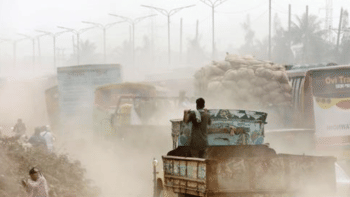Effective law and planning can control noise pollution

Dhaka, the sprawling capital of Bangladesh, is gripped by an escalating crisis of noise pollution, primarily fuelled by unregulated vehicular horns and unrelenting traffic chaos. This incessant barrage of sound has profound physiological and psychological consequences, inflicting damage that extends far beyond momentary discomfort. Noise levels in Dhaka often range between 80 and 100 decibels (dB), far exceeding the World Health Organization's (WHO) recommended safe threshold of 55 dB for residential zones.
The city's chaotic traffic—a dense mix of different kinds of vehicles—is a primary contributor to this noise crisis. Smaller vehicles, particularly rickshaws and auto-rickshaws, often use outdated mechanical horns. In addition, unregulated loudspeaker use in social gatherings, religious events, and public announcements exacerbates the situation, with noise levels frequently exceeding 120 dB in Dhaka.
While addressing vehicular noise has been a focus, it is equally vital to regulate loudspeaker usage in communal and religious settings. Religious establishments and community programmes often use high-volume speakers to reach a wider audience. Although these practices are culturally significant, it is essential to regulate sound levels lawfully to prevent public health crises.
On the physiological front, chronic exposure to such high noise levels results in a host of health issues, including Noise-Induced Hearing Loss (NIHL), hypertension, tachycardia, cardiovascular disorders, increased risks of stroke and stress-related conditions. Prolonged exposure to high-decibel noise also impairs cognitive function, reduces work efficiency, and leads to sleep disturbances, chronic fatigue, and heightened anxiety. For children, developmental delays, including cognitive and language impairments, are common consequences. Pregnant women face increased risks of foetal stress, leading to potential complications like low birth weight and developmental delays. Other stress-related conditions like epilepsy, vasovagal attacks, speech interference, headaches, memory issues, and nervous breakdowns are exacerbated by prolonged exposure to noise pollution. Extremely loud and constant noise can also lead to gastritis, colitis, and even heart attacks.
The socioeconomic impacts are equally alarming. Sleep deprivation from nocturnal noise reduces productivity, increases absenteeism, and elevates healthcare costs. Chronic medical conditions linked to noise pollution strain the healthcare system, while the diminished quality of life can deter tourism and foreign investment, further complicating Dhaka's economic challenges. Recent studies indicate that Dhaka's economic loss in terms of GDP from noise pollution amounts to billions annually.
Bangladesh's legal framework for noise pollution is outlined in the Environment Conservation Rules, 1997, which categorises noise zones into residential, commercial, industrial, and silent zones with prescribed decibel limits. For example, the maximum allowable noise level for residential areas is 55 dB during the day and 45 dB at night.
The Sound Pollution Control Rules, 2006, which specifically addresses noise pollution, provides detailed guidelines for permissible sound levels in different zones and emphasises control measures for vehicular horns and public address systems. These rules mandate obtaining prior permission to use loudspeakers in public events and impose penalties for violations. However, enforcement remains a challenge due to the lack of awareness and insufficient monitoring resources.
Stringent regulations must be enforced for vehicular noise control. Licensing protocols should include mandatory decibel-limit testing for horns across all vehicle types. For smaller vehicles like rickshaws and auto-rickshaws, the law should mandate the replacement of horns with manual ringing mechanisms to reduce overall noise pollution.
Larger motorised vehicles must adhere to a 65 dB horn limit in urban areas, with penalties including fines, licence suspension or vehicle confiscation for repeat violations. Newly manufactured vehicles must integrate advanced noise-reduction technologies, and retrofitting older models should be mandatory within a defined timeline.
Loudspeaker usage should be similarly regulated. Public address systems must include decibel limiters, capping sound levels at 75 dB in residential areas and 85 dB in commercial zones. Special attention should be paid to noise-sensitive areas such as schools, hospitals, and residential neighbourhoods, with stricter sound limits and monitoring enforced.
Technological advancements can also play a pivotal role. Smart noise sensors, strategically installed in high-traffic areas, can monitor sound levels, enabling authorities to identify hotspots and penalise violators. AI-driven traffic management systems can optimise vehicle flow, reducing congestion and unnecessary honking. Additionally, noise-dampening technologies, such as soundproofing measures at large public venues and community centres, should be encouraged. Mobile apps enabling residents to report noise violations, coupled with AI-powered monitoring systems, can transform noise regulation in Dhaka.
Public awareness is another cornerstone of effective noise control. Campaigns to raise awareness about the health hazards of noise pollution should target schools, universities and workplaces. Media must highlight the physiological and psychological toll of unchecked noise pollution, fostering a collective sense of responsibility. Community initiatives should encourage behavioural changes, such as minimising honking and adopting quieter practices in both residential and commercial zones.
Collaboration among key stakeholders is essential for sustained progress. The Bangladesh Road Transport Authority (BRTA), the Department of Environment, law enforcement agencies, and public health experts must work together to implement comprehensive solutions. Pilot projects in high-noise areas can serve as testing grounds for new initiatives before broader adoption. All vehicles, regardless of size, should undergo regular noise compliance inspections during licensing and roadworthiness evaluations. Swift penalties for violations and consistent enforcement of these regulations will be key to ensuring compliance.
Addressing noise pollution in Dhaka is not merely an environmental concern, it is a public health imperative. By implementing stronger regulations, leveraging technology, and fostering awareness, the city can significantly reduce the impact of relentless noise. This transformation will enhance the quality of life for millions, reduce the socioeconomic burden, and create a healthier, more productive urban environment.
S M Muhaiminul Islam is a researcher and member of the Institution of Engineers, Bangladesh (IEB). He can be reached at [email protected].
Dr Nishat Tasnim is a physician and alumnus of Sher-E-Bangla Medical College. She can be reached at [email protected].
Views expressed in this article are the author's own.
Follow The Daily Star Opinion on Facebook for the latest opinions, commentaries, and analyses by experts and professionals. To contribute your article or letter to The Daily Star Opinion, see our guidelines for submission.

 For all latest news, follow The Daily Star's Google News channel.
For all latest news, follow The Daily Star's Google News channel. 









Comments